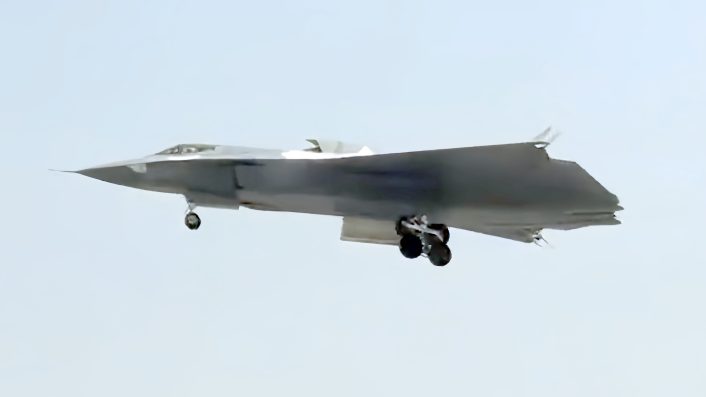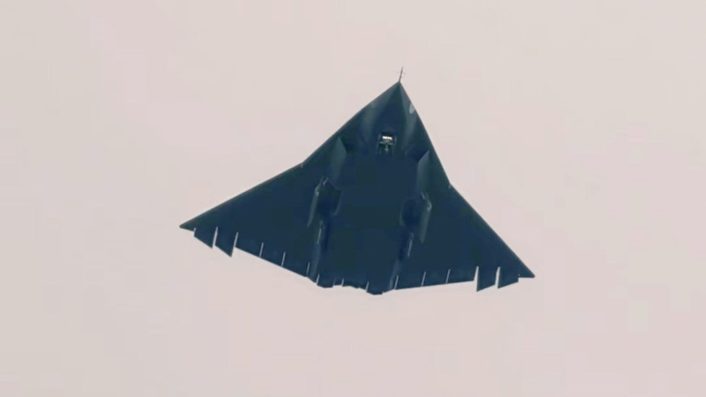The new front photo clearly shows a side-by-side seating arrangement, as well as a large main weapons bay with two smaller ones on the sides.
The Chinese J-36 has appeared in a new image, photographed on the flightline in a fully visible frontal aspect and revealing more about its design configuration. The aircraft, built by the Chengdu Aircraft Corporation (CAC), is one of China’s two new next-generation jets, along with the J-XDS.
The image is a shot off a screen, and the general consensus is that it could be genuine and not doctored. Leading Chinese military aviation researcher Andreas Rupprecht, who reshared the image from another user, has however cautioned to be “skeptical again […] since recently too many faked images of the J-36 were posted and this one looks almost too good to be true.”
Also known as the JH-XX, and commonly described as a “regional bomber” which might be laying the foundation for the even bigger H-20 strategic bomber, the aircraft appears to be still in the early stages of testing, and its role is not yet fully clear. However, three major design features are now clearly discernible in the new photo, which might be useful to better understand what the aircraft could be capable of.
Since recently too many faked Images of the J-36 were posted and this one looks almost too good to be true I would say, let‘s be sceptical again! 🤔 https://t.co/7VpVOerxE9
— @Rupprecht_A (@RupprechtDeino) June 6, 2025
Cockpit
The three-engine aircraft has now been confirmed to have a side-by-side seating arrangement. In fact, we can clearly see two wide-angle Heads-Up Displays (HUD), one for each of the pilots. This, combined with the split front canopy that can also be seen, is the most direct and incontrovertible proof of the cockpit being designed for two crew members, should the photo be confirmed to be authentic.
The configuration is similar to large strategic bombers like the B-2 Spirit and the B-21 Raider, but also tactical ground attack aircraft like the retired F-111 Aardvark or the Su-34 Fullback, which all feature two-people side-by-side cockpits. We do not know if there is also space for another crew member, possibly a flight engineer, to handle the three power plants and the array of mechanical and electronic systems onboard.
While this appears unlikely, the possibility cannot be completely excluded, given the J-36’s workload ranging from controlling the aircraft, to operating the weapons, sensors, electronic warfare and possibly even wingmen drones, which might be too much to be split between the two pilots. The B-2, for instance, was designed with an option for a third crew member, although it was not adopted.
Three more images showing the J-36 during its second flight. pic.twitter.com/B5nAmiyPlg
— @Rupprecht_A (@RupprechtDeino) March 17, 2025
Dorsal engine
The front view of the dorsal inlet shows what appears to be a Diverterless Supersonic Intake (DSI), with the outlines of a hump – already visible from the side in an Apr. 7 video – now faintly visible in the shadow. In the short 6-second clip which showed the J-36 flying over the city’s traffic while landing at the Chengdu plant, a rise in the spine, heading into the dorsal intake, suggested the presence of a DSI.

The latest image also shows a raised surface behind the dorsal intake, however it cannot be identified with certainty if this is an airbrake or something else. The flight data probe (pitot tube) is also visible.
The split trailing edge control surfaces, that also act as air brakes and were seen in both the open and closed position seen in the Apr. 7 video, are not visible in the latest image. This could be because the length of the image does not capture the wings fully, with a small segment of the wings being cut.
J-36 pic.twitter.com/PJ1Thqt4tZ
— Sweet Clay (@Clay_PLAPAP) April 7, 2025
Weapons bays
As The Aviationist reported at the time of the J-36’s second test flight captured in a Mar. 17, 2025 video, the bomber has a twin-wheeled nose landing gear and tandem-wheeled main landing gears. A bottom view of the aircraft in flight showed the main landing gears extended, encased in one large door for each of the wheel sets.
The latest front image of the J-36 on the flightline shows the massive open doors a little up close, while revealing that the tandem-wheel main landing gears are inward-facing.
The Mar. 17 video also showed the large space between the two main landing gears, which clearly has to house internal weapons bays. The shape of the doors was at the time not clearly visible and there is not enough information to have an idea about their intended payload.

In the latest image’s front-view, the weapon bays are seen open. Looking at the position and different sizes of the doors, it can be seen that the aircraft features a larger man weapon bay in the center, flanked by two smaller side weapon bays.
However, we are still far from seeing them open from a bottom view to show the internal structure, the way the J-20’s weapon bays revealed themselves for the first time during the 2018 edition of the Zhuhai Air Show. This view would allow also to see the depth of the weapon bay and have a first idea of the payload’s size.
As already noted, the steady stream of content about China’s next generation aircraft appears almost orchestrated, with each new image or clip revealing additional design details, fueling speculation among analysts and generating media buzz. At the same time, this strategy may serve a broader political purpose: showcasing technological progress and subtly putting pressure on Washington.
Conclusion
China is far from fully relying on these jets for combat and can bank upon its large fleet of 4.5 and 5th generation aircraft. Further revelations would only be in terms of visuals, with clearer top, side, bottom shots, open ordnance stores, carrying munitions, firing them, and concept renditions on Global Times, CGTN, CCTV, Xinhua and China Daily.
This was the case with the J-20, whose official revelations only remain in the realm of images and videos, beside the clearer close up shots at the 2024 Zhuhai Air Show. Except for the transition to the WS-15 engine, no Chinese report has ever identified the classification/designation of any of its subsystems like the Infra-Red Search and Track (IRST), the chin-mounted Electro-Optical System (EOTS), or Electronic Warfare (EW) capability – and possibly never will.









